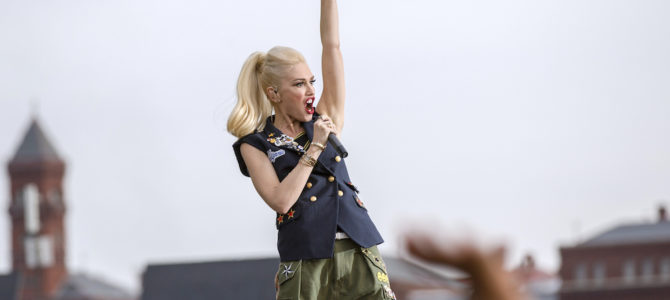
Although cancel culture clowns have done their best to personify a woke Wayback Machine that sifts through people’s pasts, making bigotry accusations and blackface scandals almost ubiquitous now, true “racism” is a serious allegation. So when somebody exposes entertainment as a “minstrel show” that’s “kind of like blackface,” we shouldn’t take it lightly.
These charges actually appear in an old article from comedian Margaret Cho more than 15 years ago — before anybody talked about microaggressions, the same year “The Office” first aired its “Diversity Day” episode, and long before Black Lives Matter existed. So why are we talking about them today? Because singer Gwen Stefani has just defended her artistic choices that prompted them.
‘Deep Fascination’
Cho’s article unleashed a wave of disapproval, meaning this isn’t the first time Stefani has fielded criticism for her entertainment decisions. Most of that blowback has centered on her “Harajuku Girls,” a troupe of four Japanese and Japanese American backup dancers whom Stefani incorporated into much of her solo songs, music videos, albums, and merchandise.
Time magazine called it “extremely racist” in 2014, and Nylon and others have bashed Stefani for “cultural appropriation.” The 21st-century race-based cultural purge has predictably brought these charges front and center again.
The “Hollaback Girl” doesn’t buy it, though, and says her attraction to all things Japanese started when she was just a little girl in 1970s Anaheim and her father would take business trips to the faraway country, long before kids had smartphones and thus virtual intercontinental transport at their fingertips. “He would be telling me these things my whole life, like my whole life,” Stefani said, recounting to Paper Magazine in an article out this week how her father would return with toys and stories about the Harajuku district. “I had a deep fascination.”
It’s a fascination that stuck with her and motivated her to perform well, she said. After traveling to Japan on a tour with No Doubt in 1996, Stefani was hooked. “If you read the actual lyrics [in ‘What You Waiting For?’], it talks about being a fan of Japan and how if I do good, I get to go back there,” she said.
It was that love of Japan and its culture that inspired Stefani to incorporate the Harajuku Girls into her solo career. “I never got to have dancers with No Doubt. I never got to change costumes. I never got to do all of those fun girl things that I always love to do,” the artist told Paper. “So I had this idea that I would have a posse of girls — because I never got to hang with girls — and they would be Japanese, Harajuku girls, because those are the girls that I love. Those are my homies. That’s where I would be if I had my dream come true, I could go live there and I could go hang out in Harajuku.”
Appreciation vs. Appropriation
The conversation should stop there, but it doesn’t. The artist’s motives should matter, but they don’t. Stefani’s love of Japan and its culture — a love she reiterates in the lyrics of the “Harajuku Girls” song when she says they’ve “got the wicked style” and “I like the way that you are, I am your biggest fan” — underpins her creative decisions. The “Harajuku Girls” song is weird (a word I would use to describe many of this superstar’s ditties), but it isn’t a mockery of Japanese culture. It’s an appreciation of it.
“Appropriation,” on the other hand, is different. Paired with “cultural,” it’s a loaded term, and it’s one that Americans who are obsessed with race love to use as an indictment not only of others’ unsavory choices, but now more commonly of their innocuous ones. Launching a tequila line is cultural appropriation. Dressing up as an animated Polynesian child for Halloween is cultural appropriation. Tiki bars are cultural appropriation. Twerking is cultural appropriation.
The line between what woke Americans would call “cultural appropriation” and what they would call “racist” is a fine one and might not even exist. After all, Stefani’s critics didn’t stop at calling her use of a Japanese dancing troupe offensive cultural appropriation. They said it was “extremely racist,” with Cho going so far as to compare it to blackface and minstrel shows, examples of dehumanizing entertainment that openly mocked black people and caricatured people of African descent.
A Cultural Crisis
It’s here that the Stefani blowback exposes an American crisis of communication that has occurred in large part because the activist left has forfeited scales of severity in our dialogue. If loving Harajuku so much that you stylize your art around it is the equivalent of a minstrel show or blackface, then how are we supposed to qualify flagrant acts of racism?
This loss of perspective is pervasive, to the point that sitting U.S. senators and the now-vice president will call a fake hate crime a “modern-day lynching,” but it explains a lot about our cultural decline. It’s why activists insist that silence is violence and murder convictions are not justice.
An obsession with cultural appropriation also reveals the deep unseriousness of self-proclaimed “anti-racists.” The modern left, with its influence in boardrooms and newsrooms and classrooms, takes every opportunity to lecture weary Americans about the enduring evil of whiteness and of white supremacy.
While their racially charged screeds are almost always unfounded, within their rhetoric is a message that threatens to cultivate white pride where it didn’t exist before. By reinforcing the idea that cultural appreciation is cultural appropriation and therefore racist, woke warriors encourage white people to insulate themselves from the cultures and experiences of others and fully embrace tribalism wherein race is a focal point.
“Most critics of cultural appropriation, coming from the far left, also fear the rise of white supremacy,” wrote Julian Adorney here at The Federalist in 2018. “But the best way to combat white supremacy is to encourage people of all races, whites included, to borrow at will from other cultures — as drawing more lines between races and cordoning off the exploration of other cultures is wholly contradictory to the end goal of creating a harmonious, diverse, and pluralist society.”
Americans who take pride in the melting-pot nature of this grand experiment would likely agree with Adorney, as does Stefani. “If we didn’t buy and sell and trade our cultures in, we wouldn’t have so much beauty, you know?” she said. “We learn from each other, we share from each other, we grow from each other. And all these rules are just dividing us more and more.”
Take a tip from Stefani. Don’t let the race-baiters bully you into giving up cultural appreciation.









